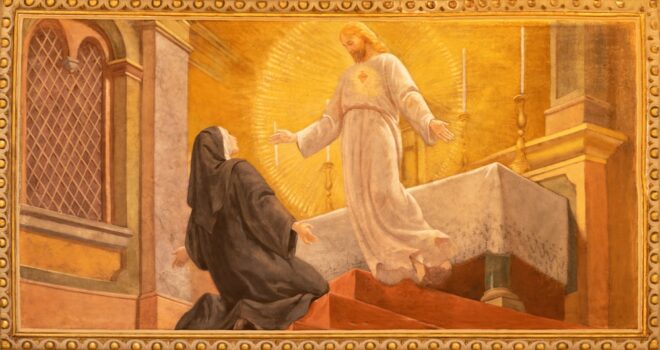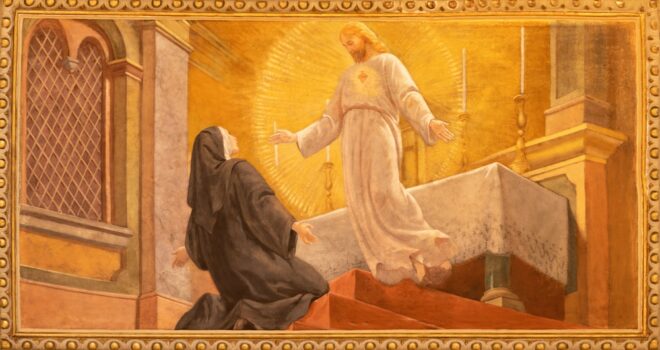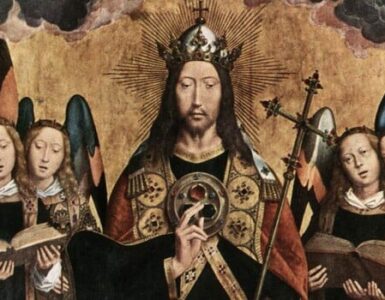“Hail, most merciful heart of Jesus.
Hail, living fountain of all grace.
Our sole shelter, our only refuge.
The light of hope issued for our race.”
As I walked down the aisle to become a consecrated virgin on the Feast of Divine Mercy Sunday of this year, the choir sang these words written by Donna Cori Gibson and based on St. Faustina Kowalska’s diary (1321).
St. Faustina of the Most Blessed Sacrament (1905-1938), whose feast we celebrate on October 5, was a religious, virgin, mystic, visionary, and apostle of Divine Mercy. She lived a largely hidden life in her native Poland. Although she felt called to become a Bride of Christ at a young age, she became distracted by the needs of her large family and worldly concerns. Then, Jesus appeared to her at a dance and her world changed. She writes in her diary Divine Mercy in My Soul:
“While everybody was having a good time, my soul was experiencing deep torments. As I began to dance, I suddenly saw Jesus at my side, Jesus racked with pain, stripped of His clothing, all covered with wounds, who spoke these words to me: How long shall I put up with you and how long will you keep putting Me off? At that moment the charming music stopped, [and] the company I was with vanished from my sight; there remained Jesus and I” (9).
It has been said that we don’t find the saints but they find us. This was definitely true of my relationship with St. Faustina on my faith journey. A friend recommended that I read her diary and I have now read it cover to cover twice and referred to it several times. When I reached the final stages of my vocational discernment, another friend remarked that my story reminded them of St. Faustina’s story at the dance.
Although it may seem that St. Faustina led an unremarkable life and was often sickly, with little formal education or extraordinary deeds, it was through her fidelity to God’s call that we received the message of Divine Mercy. On February 22, 1931, Jesus appeared to St. Faustina as she was praying before the Blessed Sacrament and gave her a message of love and mercy for the world. Emanating from the heart of Jesus were two rays of light, one red and one white. He later revealed, “These two rays issued forth from the very depths of My tender mercy when My agonized Heart was opened by a lance on the Cross” (Diary, 299).
Fr. Thomas R. Szydlik, pastor of St. John the Baptist Parish in Clinton, Illinois has visited Divine Mercy Shrine in Poland several times. Reflecting on St. Faustina, he shared, “As I think about her life and vocation, a couple of things stand out immediately: The Lord did not call St. Faustina because she was qualified to do the work. Frankly, her religious superiors were far more skilled than she was to communicate the message of mercy. Yet, the Lord chose her. She was led on a path of conversion to trust in Jesus. At different points along the way, you can see that she did not have perfect trust in Him. In her diary, and in the story of her life, you can see Jesus, correcting her and leading her towards greater trust in Him. It’s a great source of encouragement for us who may struggle at times to trust.”
Jesus asked St. Faustina to step out in faith and tell the world of His great love and mercy by spreading the Mercy of God devotion. Many of her visions of Jesus took place as she prayed before Him in the Holy Eucharist. Each time a person entered the chapel and visited Jesus exposed in a monstrance, she saw His Divine rays of love and mercy burst forth and encircle the whole world and everyone in it with His graces and blessings!
“My Heart overflows with great mercy for souls, and especially for poor sinners. If only they could understand that I am the best of Fathers to them and that it is for them that the Blood and Water flowed from My Heart . . . For them I dwell in the tabernacle as King of Mercy. I desire to bestow grace upon souls . . . They have time for everything, but they have no time to come to Me for graces” (Diary, 367).
Over the course of Jesus’ many visits to St. Faustina, He revealed to her the Divine Mercy image, Chaplet, Novena, and His desire for the Feast of Divine Mercy. Jesus asked her to have a picture of Him painted, one that would show His loving, merciful Heart with rays of tenderness and healing flowing forth, with the words: “Jesus, I trust in You.” He asked her to recite the chaplet daily at 3:00 p.m., the Hour of Great Mercy, and to say it unceasingly. Jesus promised that “Whoever will recite it will receive great mercy at the hour of death. Priests will recommend it to sinners as their last hope of salvation.”
In her book, Jesus Speaks to St. Faustina and You, Susan Tassone provides daily reflections about quotes from St. Faustina’s diary. She explains how “St. Faustina encourages us to appeal to His mercy by making a good confession. Afterwards, restored by God’s grace, Jesus feeds us with the spiritual food that strengthens our souls, His Body and Blood. St. Faustina tells us that the whole secret of the soul’s sanctity is the Holy Eucharist.”
A few years ago, while doing a summer program in Austria through the Franciscan University of Steubenville, Catherine Bracy of Carthage, New York, also went on a pilgrimage to Poland. She described her experience at the original Divine Mercy Shrine, “As we walked into the beautiful chapel containing one of the original Images, the sisters were singing Vespers in Polish. There was also a short time of Adoration before they said the Chaplet. It was such an anointed time, I thought, ‘I could stay here forever, or at least a while.’ It really was beautiful seeing the monstrance flanked by the Divine Image on the left, a statue of the Blessed Mother behind, and a painting of St. Joseph on the right.”
Throughout her diary, Jesus affirms the depths of His love for St. Faustina and all of us in the Holy Eucharist. He reminded her that “Mankind will not have peace until it turns with trust to My mercy.” Jesus also said that the Blessed Sacrament is the “throne of mercy on earth” and to daily “Adore, in the Blessed Sacrament, My Heart, which is full of mercy.” “I want Adoration to take place . . . for the intention of imploring Mercy for the world” (Diary, 300, 1485, 1572, 1070).
Our Lord invites us to join St. Faustina on her mission. “Call upon My mercy on behalf of sinners; I desire their salvation. When you say this prayer, with a contrite heart and with faith on behalf of some sinner, I will give him the grace of conversion. The prayer is this: O Blood and Water, which gushed forth from the Heart of Jesus as a fount of mercy for us, I trust in You” (Diary, 186).
St. Faustina said that her mission would continue after her death and that she would not forget us (Diary, 281, 1582). In imitation of her patroness, St. Therese, her little way of childlike surrender reminds us of God’s invitation to come to Him with total confidence. Natalie Batt, a wife, mother, and copy editor at Copyedit Mom, LLC, reflected, “St. Faustina’s courage, strength of will, and incredible love and trust in God’s mercy — in the midst of her own humanity and weaknesses, too — were some of the things I clung to during one of the most difficult times of my life. She is a true friend, and I will always be grateful that she and St Thérèse both were (and are!) messengers of His Merciful Love. The world desperately needs to know Him in that way.”
On the back of my commemorative card for my consecration to a life of virginity lived in the world is printed these words from Jesus to St. Faustina: “Snuggle close to My Merciful Heart, and I will fill it with peace” (1074). May we follow in the footsteps of St. Faustina and proclaim the mercies of the Lord.










